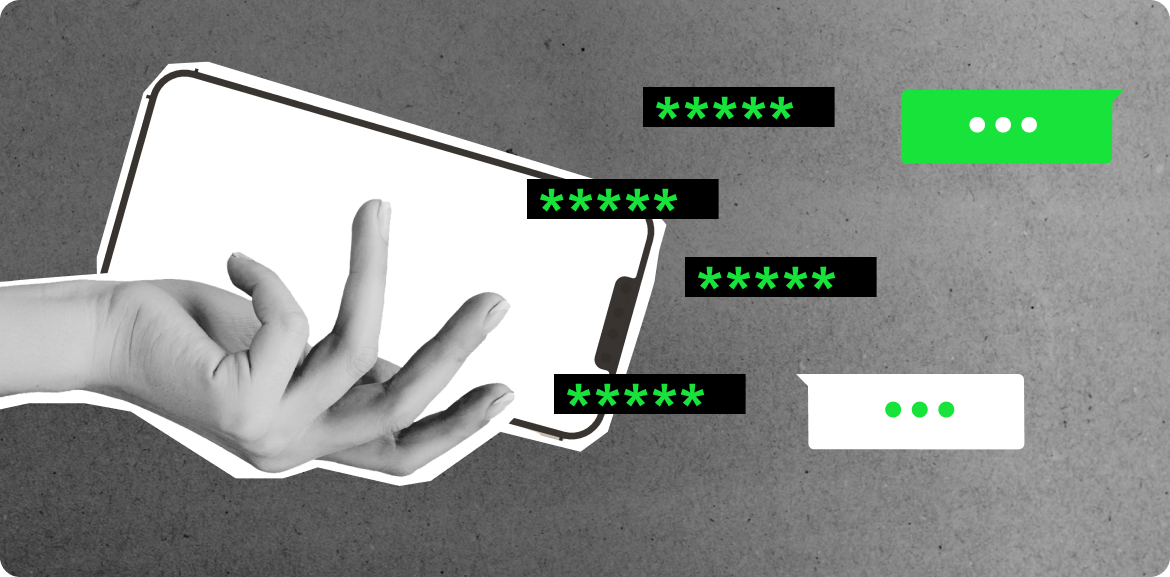WhatsApp OTPs – A Comprehensive Guide to Using Them in 2024!

One-time passwords (OTPs) have become a critical tool for businesses today. With digital interactions between businesses and customers at an all-time high, securing customer accounts and preventing frauds has become a top priority for businesses. OTPs are the perfect way for businesses to add an additional layer of security. Unlike static passwords, OTPs are valid for only a single session or transaction, making them useless to hackers even if intercepted. This dynamic nature significantly reduces the risk of unauthorized access and protects the user’s identity. Also, since OTPs are not reusable and are typically used alongside a regular password (two-factor authentication), they offer protection against phishing attacks. Hackers might obtain a regular password, but without the OTP, they cannot gain access, protecting the user’s sensitive information. Customers feel more secure when businesses use OTPs for transactions or during the login process. Also, the fact that they do not have to remember the OTP for future use adds to the comfort. This enhanced security feature increases customer confidence in the platform and can lead to increased usage and transactions.
While we tend to think of SMS as one of the most preferred channels for sending OTP codes, WhatsApp has also emerged as a highly effective channel for sending OTPs securely. Using their WhatsApp’s official channel, businesses can send unique passcodes to their customers’ registered WhatsApp numbers in a quick and highly secure way. A number of reasons can be attributed to WhatsApp’s rise as a channel for sharing OTPs.
Benefits of Using WhatsApp to Send OTPs vis-à-vis SMS
Switching from SMS to WhatsApp for sending OTPs can enhance the security, reliability, and user experience of these critical communications. With its global reach and cost-effective messaging solutions, WhatsApp presents a compelling alternative to traditional SMS, aligning with modern communication trends and consumer preferences. WhatsApp has a number of advantages when it comes to sending OTPs, especially when compared to SMSs:
Higher Delivery Reliability
WhatsApp OTPs generally enjoy higher delivery success rates compared to SMS. While SMS can sometimes fail due to network issues or be blocked by carriers as spam, WhatsApp, which operates over the internet, tends to be more reliable in delivering messages promptly and successfully.
End-to-End Encryption
Security is a paramount concern with OTPs, and WhatsApp offers end-to-end encryption for all messages. This means that WhatsApp OTP codes are secured from the point they are sent until they are received, with no third parties, not even WhatsApp itself, having access to the content. This is a significant advantage over SMS, which can be intercepted more easily.
Cost-Effectiveness
Sending messages via WhatsApp can be more cost-effective than SMS. While SMS costs can vary based on carrier rates and international fees, WhatsApp messages only require internet access, potentially reducing operational costs for businesses, especially for those that operate globally.
User Experience
WhatsApp is a highly popular messaging platform with a user-friendly interface, which most users check more frequently than their SMS inbox. Delivering OTPs via WhatsApp can lead to a smoother and faster user experience, with users more likely to notice and respond to notifications.
Global Reach
WhatsApp has a whopping 2 billion active users globally, which allows businesses to reach customers worldwide without the need for multiple agreements with different SMS providers in various countries. This unified approach can simplify operations and ensure a consistent experience for all users.
Rich Media Capabilities
Unlike SMS, WhatsApp allows for the sending of rich media along with text. Although not typically necessary for OTPs, this feature can be useful for follow-up communications that might require sending images, videos, documents, or other types of media.
Read Receipts
WhatsApp provides instant feedback via read receipts, letting senders know when messages have been delivered and read. This feature is particularly useful for critical communications like OTPs, as it allows businesses to ensure that the message has reached the user, and even use fallback channels in case the message has not been delivered.
“>Reduced Spam Risk
Users may perceive SMS as less secure and more spam-prone. WhatsApp’s user-controlled privacy settings and the familiarity of the platform can increase trust and comfort among users, reducing the perception of OTP messages as potential spam. WhatsApp OTPs can be shared only via templates, i.e., predefined message formats used to send OTPs to users via WhatsApp for authentication or verification purposes. These templates are part of the WhatsApp Business API, which businesses use to automate and streamline their communications. The templates are crucial for maintaining a consistent and professional interaction with customers while adhering to WhatsApp’s guidelines and policies.
“>Integration with Business Services
WhatsApp offers a robust API for business integration, allowing automated systems to send OTPs seamlessly as part of broader customer interaction workflows. This integration can be more complex with SMS, especially when coordinating across different regions and carriers.
Legality and Regulatory Considerations of Using WhatsApp OTPs in Various Countries
Using WhatsApp to send OTPs involves navigating a complex landscape of regulations and legal considerations that can vary significantly from one country to another. The legality of using WhatsApp for sending OTPs is largely dependent on regional data protection laws and regulations regarding electronic communications. Businesses must carefully assess their practices against local laws and ensure they have robust systems for obtaining user consent and ensuring data security. Compliance with these legal frameworks not only protects the business from potential penalties but also builds trust with customers by safeguarding their personal information.
Here’s an overview of some regional considerations and specific rules regarding the use of WhatsApp for sending OTPs:
European Union (EU)
In the EU, the General Data Protection Regulation (GDPR) sets stringent guidelines on data privacy and protection. When using WhatsApp to send OTPs, companies must ensure that they have explicit consent from users to send OTPs via this platform. Additionally, businesses must ensure that WhatsApp’s data handling practices comply with GDPR requirements, particularly regarding data transfer outside the EU. Given WhatsApp’s end-to-end encryption, it generally is considered secure, but businesses must still ensure all communications comply with GDPR.
United States
In the U.S., regulations like the Telephone Consumer Protection Act (TCPA) govern the use of electronic communications. Businesses must obtain explicit consent from consumers before sending them automated text messages, including OTPs. While specific laws governing WhatsApp usage for such purposes are not explicit, compliance with consent requirements under TCPA is mandatory. Businesses should also consider state-specific privacy laws, like the California Consumer Privacy Act (CCPA), which mandates transparency about data use and provides consumers with rights over their personal information.
India
India’s IT laws and the regulations governed by the Telecom Regulatory Authority of India (TRAI) include specific directives on the use of OTPs for securing transactions and services. With WhatsApp’s widespread popularity in India, it is a favourable platform for sending OTPs, provided businesses comply with TRAI guidelines on telemarketing and user consent. Additionally, the Personal Data Protection Bill, once enacted, will require businesses to adhere to strict guidelines concerning user data.
Brazil
In Brazil, the General Data Protection Law (LGPD) is similar to the EU’s GDPR and requires strict adherence to data protection and privacy norms. Companies using WhatsApp for sending OTPs must ensure that they have user consent and that all data handling practices are transparent and comply with LGPD requirements.
Singapore
Under Singapore’s Personal Data Protection Act (PDPA), organizations must obtain consent before collecting, using, or disclosing personal data for business purposes, which would include sending OTPs via WhatsApp. The use of such platforms must also ensure that the data is transferred securely to prevent unauthorized access.
Real Life Use Cases of WhatsApp OTPs
WhatsApp OTPs are increasingly being utilized across various sectors due to their convenience and high user engagement. They serve as an effective tool for authentication, enhancing security while providing a seamless user experience. Some of the most common WhatsApp use cases are:
User Registration
During the registration process, businesses send an OTP via WhatsApp to verify the user’s phone number, ensuring that the information provided is accurate. Many e-commerce platforms have adopted WhatsApp for sending OTPs during new user registration, which has improved user experience by streamlining the process and reducing dropout rates during sign-up.
User Login
Businesses use WhatsApp OTPs for secure user login, especially for services requiring quick yet secure access. Banks like HDFC in India have started using WhatsApp to send OTPs for user logins to their online banking portal. WhatsApp OTPs serve as a second factor in two-factor authentication (2FA) setups, where a user must verify their identity with something they know (password) and something they receive (OTP). Microsoft allows users to receive their 2FA codes via WhatsApp. Integrating WhatsApp into 2FA processes has led to higher adoption rates of 2FA among users due to the convenience of receiving codes on a commonly used platform.
“>Password Reset and Account Recovery
For users who forget their passwords or need to recover their accounts, WhatsApp OTPs provide a secure method to verify user identity before allowing password resets. Airbnb has implemented a system where users can receive their password reset codes via WhatsApp. This method has made the recovery process much quicker and more user-friendly, while also ensuring that account recovery requests are legitimate.
Transaction Confirmation
To enhance security for online transactions, companies send OTPs via WhatsApp to confirm the user’s identity before processing transactions. Paytm, a leading payment gateway in India, uses WhatsApp OTPs to confirm transactions. This additional layer of security helps prevent unauthorized transactions and boosts user confidence in the safety of the platform.
Payment Authorization
WhatsApp OTPs are used to authorize payments, adding an extra security layer by verifying the transaction initiator’s identity. For example, Brazil’s Banco Itaú allows customers to use WhatsApp to authorize credit card transactions. Users receive an OTP on WhatsApp, which they must enter to complete transactions, significantly reducing credit card fraud.
WhatsApp’s Integration Capabilities
Integrating WhatsApp with core banking systems that manage customer accounts, process transactions, and support financial services is essential to make it a robust solution for delivering OTPs securely. Most modern core banking systems support WhatsApp API integrations. The WhatsApp Business API can be integrated directly with these systems to trigger OTPs during transactions like online payments, account logins, or any other action requiring authentication.
WhatsApp-CRM system integration is also easy to achieve as CRM systems generally offer extensive API support. Some CRMs like Bitrix CRM have direct native integration, which makes the process of sending OTPs even easier. WhatsApp Business API can be integrated into these systems to send OTPs directly when a customer initiates a service request that requires authentication.
When it comes to integration with data warehousing and analytics tools, Teradata, Google BigQuery, and Amazon Redshift, and other such tools store vast amounts of transactional data. Integrating these tools with WhatsApp for OTP delivery isn’t direct but involves leveraging the data for enhanced security measures.
How to Send WhatsApp OTPs?
WhatsApp OTPs can only be sent if you have a WhatsApp Business API connection. To get the WhatsApp Business API, you need to select a reliable WhatsApp Business solutions provider like edna. To find out more about how you can set up the WhatsApp Business API, read this. Once you have your own WhatsApp Business API account, you can use create your own message template and submit it to WhatsApp for approval, or use one of edna’s many preapproved OTP templates. For more information related to template creation, read this.




![[photo]](https://edna.io/wp-content/themes/edna/images/authors/rajrupa-ghoshal.jpg)
![[icon]](https://edna.io/wp-content/themes/edna/images/authors/ico-linkedin.svg)